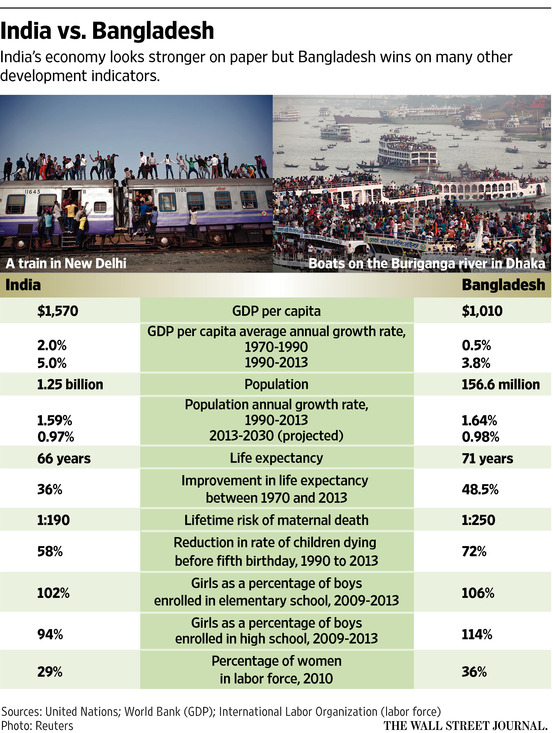INDIAPOSITIVE
ELITE MEMBER

- Joined
- Sep 20, 2014
- Messages
- 9,318
- Reaction score
- -28
- Country
- Location
India is richer, in terms of per-capita economic output, than its smaller neighbor, Bangladesh, and a greater proportion of Indians are connected to the Internet and have cellphones.
But if you look more closely at other measures of development such as life expectancy, child survival and the proportion of girls to boys in secondary education, and Bangladesh comes out ahead.
The two countries spend the same proportion (1%) of their gross domestic product on healthcare, but India devotes more of its GDP (3%) to education than Bangladesh (2%).
Still, 20 years of targeted financial support in Bangladesh to get girls to go to high school rather than, for example, get married, has helped dramatically shifted the needle on human-development indicators there.
“Gender equality is good for economic growth and good for human development. That is really part of what explains the quite remarkable achievements in Bangladesh,” said Christine Hunter, country representative for U.N. Women in Bangladesh.

In pursuit of the 2015 Millennium Development Goal to redress the lopsided gender imbalance in high schools
But if you look more closely at other measures of development such as life expectancy, child survival and the proportion of girls to boys in secondary education, and Bangladesh comes out ahead.
The two countries spend the same proportion (1%) of their gross domestic product on healthcare, but India devotes more of its GDP (3%) to education than Bangladesh (2%).
Still, 20 years of targeted financial support in Bangladesh to get girls to go to high school rather than, for example, get married, has helped dramatically shifted the needle on human-development indicators there.
“Gender equality is good for economic growth and good for human development. That is really part of what explains the quite remarkable achievements in Bangladesh,” said Christine Hunter, country representative for U.N. Women in Bangladesh.

In pursuit of the 2015 Millennium Development Goal to redress the lopsided gender imbalance in high schools
- Bangladesh began the secondary-school subsidy program for girls in 1993.
Funded by the government, the Asian Development Bank, the Norwegian Agency for Development Cooperation and the European Union, the education-payment program contributed to a tripling of participation rates of girls in secondary school between 1991 and 2005, according to a World Bank analysis. Bangladesh met the goal ahead of time.
Some 88% of women are literate in Bangladesh, compared to 68% of women in India. Though the overall adult literacy rate is lower in Bangladesh (59%) than in India (63%).
“The moment that there was education equality, there was power of the mind, then there was financial power,” said Joyeeta Bhattacharjee, research fellow on Bangladesh from Observer Research Foundation, a New Delhi based think tank. “That is really helping Bangladesh to change.”
The gains in female education have, along with the booming garment industry, helped boost female participation in the paid labor force.
Around 36% of women were in paid jobs in Bangladesh in 2010, up from just 14% in 1990, according to the International Labor Organization.
By comparison, in India, female employment has gone backwards in recent years —from 37% in 2004-05 to 29% in 2009, according to the ILO.
Empowering women financially and establishing a thriving micro-credit system for female led small businesses, has also meant women have more say over financial decisions in the family.
“They try to prioritize health and education across everyone in their family,” said Ms. Hunter of the U.N.
From roughly the same base as India, Bangladesh has brought its life expectancy for both men and women up from 47 years to 70 years since 1970. Indians, on average, live to 66, according to United Nations’ data.
Child mortality rates too have come down, from 144 deaths per 1,000 under-fives in 1990 in Bangladesh, to 41 in 2013.
In that time, India has moved the dial on child mortality from 126 deaths per 1,000 children aged under five years old to 53 per 1,000.
India ranks 13 places below Bangladesh in child mortality globally.
“India can learn from the support that the government in Bangladesh has given to NGOs,” said Ms. Bhattacharjee. “It is trying to learn from the microcredit system.”
How Poorer Bangladesh Outpaces India on Human-Development Indicators - India Real Time - WSJ









